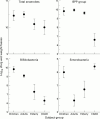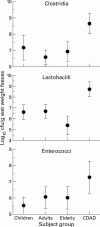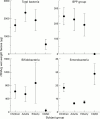Age and disease related changes in intestinal bacterial populations assessed by cell culture, 16S rRNA abundance, and community cellular fatty acid profiles
- PMID: 11156640
- PMCID: PMC1728209
- DOI: 10.1136/gut.48.2.198
Age and disease related changes in intestinal bacterial populations assessed by cell culture, 16S rRNA abundance, and community cellular fatty acid profiles
Abstract
Background: The normal intestinal microflora plays an important role in host metabolism and provides a natural defence mechanism against invading pathogens. Although the microbiota in adults has been extensively studied, little is known of the changes that occur in the microflora with aging. These may have important consequences in elderly people, many of whom are receiving antibiotic therapy and who are most susceptible to intestinal dysbiosis.
Aims: To characterise the major groups of faecal bacteria in subjects of different ages using a combination of cultural, molecular, and chemotaxonomic approaches.
Methods: Comparative microbiological studies were made on four different subject groups: children (16 months to seven years, n=10), adults (21-34 years, n=7), healthy elderly subjects (67-88 years, n=5), and geriatric patients (68-73 years, n=4) diagnosed with Clostridium difficile diarrhoea. Selected faecal bacteria were investigated using viable counting procedures, 16S ribosomal RNA (rRNA) abundance measurements, and the occurrence of specific signature fatty acids in whole community fatty acid methyl ester profiles.
Results: The principal microbiological difference between adults and children was the occurrence of higher numbers of enterobacteria in the latter group, as determined by viable counts (p<0.05) and 16S rRNA (p<0.01) measurements. Moreover, a greater proportion of children's faecal rRNA was hybridised by the three probes (bifidobacteria, enterobacteria, bacteroides-porphyromonas-prevotella) used in the study, indicating a less developed gut microbiota. Species diversity was also markedly lower in the Clostridium difficile associated diarrhoea group, which was characterised by high numbers of facultative anaerobes and low levels of bifidobacteria and bacteroides. Although it was a considerably less sensitive diagnostic tool, cellular fatty acid analysis correlated with viable bacterial counts and 16S rRNA measurements in a number of bacteria, including bacteroides.
Conclusions: Polyphasic analysis of faecal bacteria showed that significant structural changes occur in the microbiota with aging, and this was especially evident with respect to putatively protective bifidobacteria. Reductions in these organisms in the large bowel may be related to increased disease risk in elderly people.
Figures



References
Publication types
MeSH terms
Substances
LinkOut - more resources
Full Text Sources
Other Literature Sources
Medical
